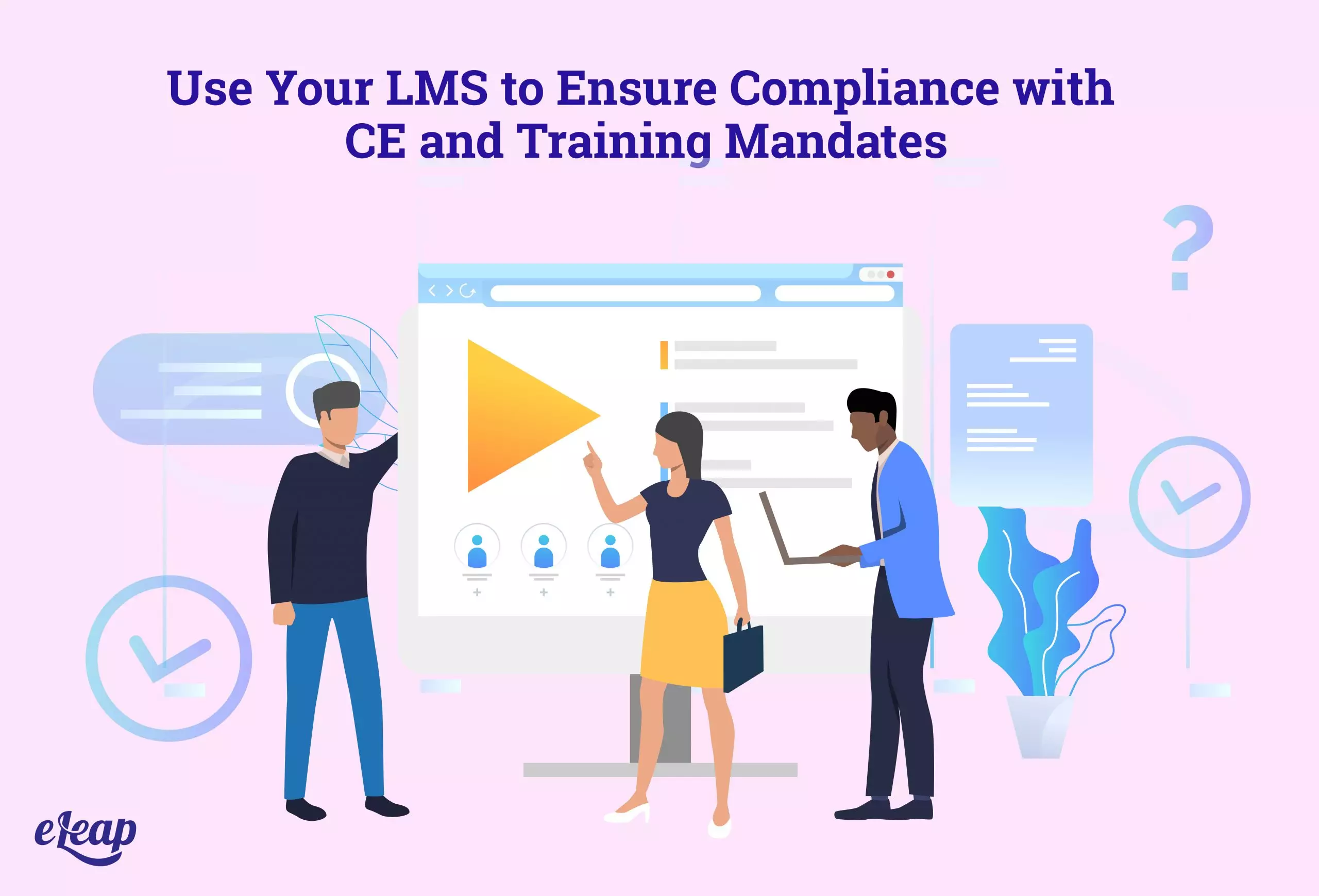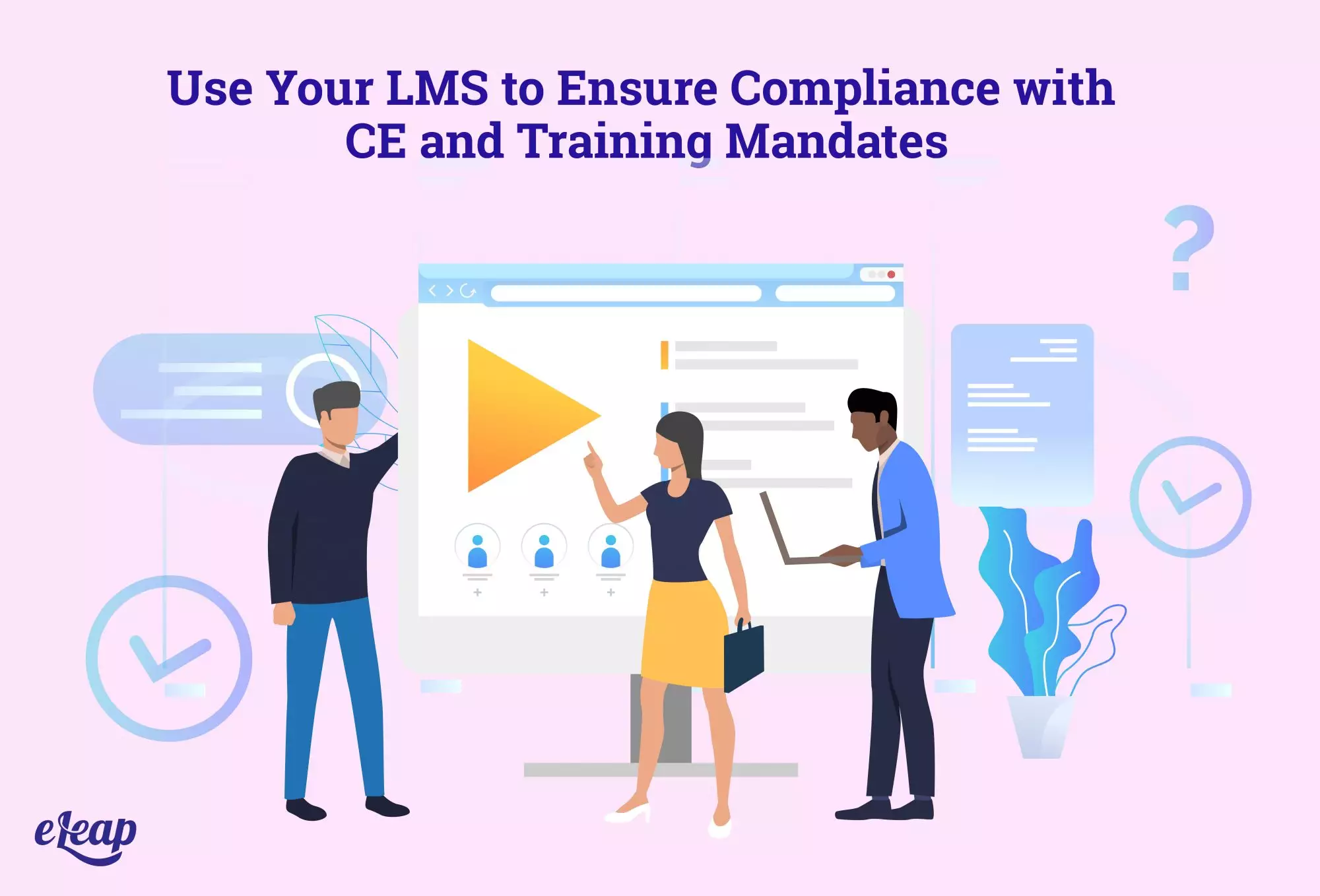Use Your LMS to Ensure Compliance with CE and Training Mandates

Compliance – it’s a term that makes managers and execs sigh in frustration. Laws, rules, and regulations require that your team members comply with education and training mandates. They require that they regularly re-up their certification, complete a specific number of continuing education (CE) hours or complete specific training courses regularly to ensure they are maintaining compliance with all kinds of professional educational credits required.
It can be exhausting and frustrating, but you have an unexpected ally in your fight to stay compliant with the right learning management system. How can an LMS help ensure compliance with CE and training mandates? We’ll explore that and more below.

1. The Right LMS
The first thing to consider is whether or not you have the correct LMS in place. There are different options out there. Some are designed specifically for mandatory corporate training – think sexual harassment or diversity training. These classes are required for all employees at all levels of an organization.
Another type of LMS is designed for continuing education (often voluntary, rather than mandatory). In this situation, learners can take courses that help them advance their careers, learn new skills, and build their knowledge. This type of LMS rarely supports compliance-related training, though.
The third type of LMS is designed for mandatory CE where certification or recertification is necessary. Many professions have CE requirements that must be completed within specified times, usually one to two years, although these can vary greatly. Think of nurses or of InfoSec professionals who must keep their knowledge up to date.
The right LMS is none of these. Instead, it’s one that can accommodate all needs. Most businesses have a combination of different training requirements. Using a different LMS-like system for each need creates a fragmented training experience and confuses your employees.
Instead, opt for a single LMS that can handle all your training requirements, whether those are voluntary CE, compliance-related CE, or mandatory corporate training options.
2. Consider Certificates
Where industry or government-mandated CE is concerned, certification is usually required, too. Make sure that the LMS you choose can produce certificates that are customizable to multiple requirements, including the following:
- State requirements
- Federal requirements
- Regional requirements
- Industry requirements
Some of the things a certificate may require include:
- Accreditation number
- Course number
- Account number
- Compliance-related imagery or data
3. Credit Transmission
Mandatory CE for professionals requires that you do more than provide training to your employees and then create a certificate. The governing body must also be made aware that each employee has completed their required education units. Your LMS should be able to automatically transmit CE credits to that governing body and takes additional responsibilities and weight off both you and the employee. Ideally, credit transmission should happen as soon as the employee completes the required number of training hours or specific modules/units.
4. The Right User Interface
This tip might sound a little strange, but it is important. While your employees know a lot about their responsibilities, they may or may not be all that familiar with technology. Make sure that the LMS has a user-friendly interface that allows easy access to the required modules or units.
Ideally, your LMS will have a single log-on dashboard that can be customized to each employee. This ensures that all of your team members can easily access training that is specific to their needs and their career path. It also helps ensure that your LMS is usable by all types of learners, whether they’re completing voluntary training, professional CE, or mandatory corporate training.
5. Locked Progression
When it comes to mandatory training and professional CE, progression matters. Your learners must complete one module before they can move to the next. However, there is sometimes the temptation to progress in a piecemeal fashion – employees may want to switch things up, break up the routine, or may simply be unaware of what module comes next.
Course locking is a tool that allows you to lock specific modules until the preceding one is completed. On completion, the employee then has access to the next module or even a selection of modules. It creates a defined path of completion and ensures that the required components are completed in order.
While course locking is important for professional CE and mandatory corporate training, it can also be important in other instances. For example, if you are trying to provide your employees with career development and progression tools, you can map their career path to specific training modules. By locking more advanced modules or lessons, you ensure that they can progress in the right direction, master basic topics first, and then build their expertise and knowledge over time.
6. Restrict Progress Capabilities
While course locking restricts learners to a specific path of completion, it does not necessarily require that they complete the entirety of a course before moving on. Make sure that your LMS can restrict progress. Here are a couple of examples of how this might work:
- Video Content – Limit your learners’ access to skip and fast forward with video content. They should only be able to play or pause video content to ensure that they watch the entire thing.
- Course Content – Make sure that your LMS can require all course content to be completed before marking it as complete. For instance, an employee would have to move through all the slides in a digital slideshow before that segment could be marked as complete.
7. Identity Verification
Because CE is required for licensure, some employees may be tempted to have someone else take the test for them. This is particularly true in remote testing via mobile devices. Make sure that your LMS can require identity verification not just at login, but periodically throughout the course.
In Conclusion
Complying with CE and corporate training mandates doesn’t have to be a challenge. The right LMS can provide you and your employees with access to powerful tools that streamline and simplify the process while also helping to ensure that employees master all the material.